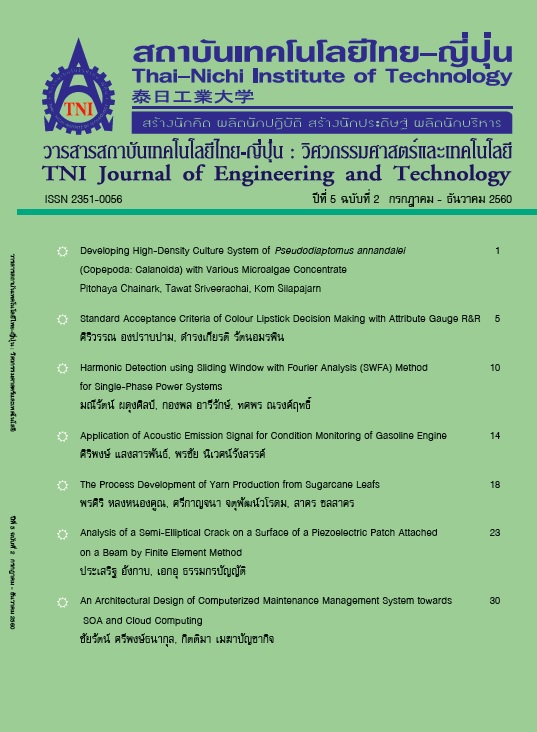Application of Acoustic Emission Signal for Condition Monitoring of Gasoline Engine
Main Article Content
Abstract
A gasoline engine condition monitoring uses an accelerometer to monitor engine. Typically, detected vibration signal is included considerable noise (<1000 Hz) that related to moving parts and mechanisms of rotating machine. The use of acoustic emission signal can help to clearly identify various processes in the gasoline engine cycle. This study was used acoustic emission sensor to investigate mechanisms of 4-stoke, 4-cylinder, Suzuki gasoline engine with capacity of 1600 cc such as the operation of intake and exhaust valves, clearance intake and exhaust valve faults and injector faults when engine was running with no load and load of 10 and 20 Nm. It is found that acoustic emission signal can be used to monitor engine operations and also can be used to predict various simulated engine conditions of normal and abnormal engines with better result than vibration signal.
Article Details
Article Accepting Policy
The editorial board of Thai-Nichi Institute of Technology is pleased to receive articles from lecturers and experts in the fields of engineering and technology written in Thai or English. The academic work submitted for publication must not be published in any other publication before and must not be under consideration of other journal submissions. Therefore, those interested in participating in the dissemination of work and knowledge can submit their article to the editorial board for further submission to the screening committee to consider publishing in the journal. The articles that can be published include solely research articles. Interested persons can prepare their articles by reviewing recommendations for article authors.
Copyright infringement is solely the responsibility of the author(s) of the article. Articles that have been published must be screened and reviewed for quality from qualified experts approved by the editorial board.
The text that appears within each article published in this research journal is a personal opinion of each author, nothing related to Thai-Nichi Institute of Technology, and other faculty members in the institution in any way. Responsibilities and accuracy for the content of each article are owned by each author. If there is any mistake, each author will be responsible for his/her own article(s).
The editorial board reserves the right not to bring any content, views or comments of articles in the Journal of Thai-Nichi Institute of Technology to publish before receiving permission from the authorized author(s) in writing. The published work is the copyright of the Journal of Thai-Nichi Institute of Technology.
References
F. Gu, W. Li, A. Ball, and A. Y. . Leung, “The Condition Monitoring of Diesel Engines Using Acoustic Measurements Part 1: Acoustic Characteristics of the Engine and Representation of the Acoustic Signals,” SAE Technical Papers, Mar. 2000.
F. Gu, A. Ball, and W. Li, “The Condition Monitoring of Diesel Engines Using Acoustic Measurements-Part 2: Fault Detection and Diagnosis,” SAE Technical Papers, Mar. 2000.
S. Klinchaeam and P. Nivesrangsan, “Condition monitoring of valve clearance fault on a small four strokes petrol engine using vibration signals,” Songklanakarin Journal of Science and Technology, vol. 32, pp. 619–625, Dec. 2010.
J. D. Gill, R. L. Reuben, J. A. Steel, M. W. Scaife and J. Asquith, "A study of small HSDI diesel engine fuel injection equipment faults using acoustic emission,"in Proceedings of the 24th European Conference on Acoustic Emission Testing, France, 2000, pp. 281-286.
A. K. Frances, J. D. Gill, R. L. Reuben and J. A. Steel, "A study of the variability of acoustic emission signals from a medium size marine diesel engine under service conditions," in Proceedings of the 16th International Congress, Condition Monitoring and Diagnostic Engineering Management, Sweden, 2003, pp. 503-512.


